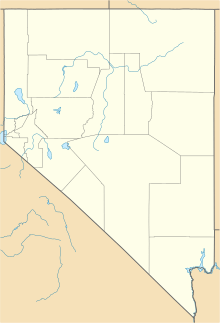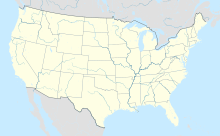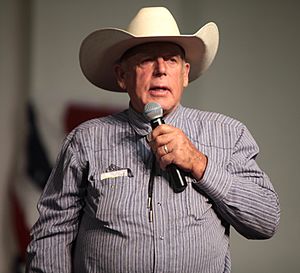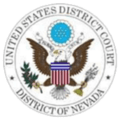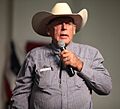Bundy standoff facts for kids
Quick facts for kids Bundy standoff |
|||
|---|---|---|---|
| Date |
|
||
| Location |
36°43′00″N 114°14′19″W / 36.716574°N 114.238483°W |
||
| Caused by |
|
||
| Goals |
|
||
| Resulted in |
|
||
| Parties to the civil conflict | |||
|
|||
| Lead figures | |||
|
|||
The 2014 Bundy standoff was a tense situation between supporters of rancher Cliven Bundy and government law enforcement. It happened after a long legal disagreement. The U.S. Bureau of Land Management (BLM) had court orders telling Bundy to pay over $1 million. This money was for fees because Bundy's cattle were grazing on federal land near his ranch in southeastern Nevada.
On March 27, 2014, a large area of federal land in Clark County was temporarily closed. This was so the BLM could "capture, impound, and remove" Bundy's cattle that were there without permission. BLM officials and law enforcement began gathering the cattle on April 5. Cliven Bundy's son, Dave, was arrested.
By April 12, 2014, many protesters, some carrying weapons, gathered near the BLM's cattle operation. Sheriff Doug Gillespie talked with Bundy and the BLM director, Neil Kornze. They decided to release the cattle and calm the situation down. Even by the end of 2015, Cliven Bundy was still grazing his cattle on federal land. He had not paid the grazing fees.
The problem started in 1993. Bundy refused to renew his permit for grazing cattle on BLM-managed public lands near Bunkerville, Nevada. He was protesting new grazing rules. Bundy claimed the federal government didn't have the right to own so much land. However, federal courts have always disagreed with this idea. The BLM said Bundy kept grazing his cattle on public land without a permit. In 1998, a federal court told Bundy he could not graze his cattle in an area called the Bunkerville Allotment. In July 2013, another federal judge ordered Bundy to stop using federal land in the Gold Butte area of Clark County.
Cliven and his son Ammon Bundy, along with their supporters, argued that the federal government shouldn't manage public lands. Legal experts and federal courts, including the U.S. Supreme Court, have rejected these arguments many times. The Property Clause of the U.S. Constitution gives Congress full power to manage federal property, including land.
Contents
- What Led to the Standoff?
- The Court Cases Against Bundy
- Court Decisions Against Bundy's Claims
- BLM's Actions
- Confrontations and Protests in April 2014
- Events After April 2014
- Aftermath and Reactions
- 2016 Standoff and Arrests
- Legal Outcomes for Some Participants
- Lawsuits After the Standoff
- Images for kids
What Led to the Standoff?
How the Land Became Federal
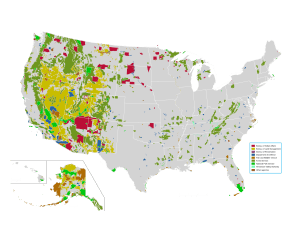
The land Cliven Bundy claimed was originally home to the Moapa Paiute people. In 1848, after the Mexican-American War, the United States bought this land from Mexico. This area is now the southwestern U.S.. Since then, the government has owned land in what is now Nevada. This includes the Bunkerville Allotment.
Nevada became a state in 1864. Since 1934, federal rangelands in Nevada have been managed by the Bureau of Land Management (BLM) or similar agencies. As of 2010, the BLM managed over two-thirds of Nevada's land. Across the country, the BLM manages nearly 18,000 grazing permits. About 700 of these are in Nevada. These permits set rules for how and when land can be used for grazing.
Grazing Permits and Rules
Bundy legally grazed his cattle and paid fees on the Bunkerville Allotment from 1954 until 1993. In 1989, the desert tortoise was declared an endangered species. This led to new plans to protect its habitat in Clark County, Nevada. These plans aimed to balance the needs of the tortoise with people using the land.
By 1993, a permanent conservation plan was in place. This plan included the Bunkerville Allotment. It meant stopping livestock grazing and limiting off-road vehicles in protected tortoise areas.
Unlike many ranchers, Bundy refused to sell his grazing rights back to the government. Instead, he stopped paying his renewal fees in 1993 as a protest. His permit was canceled in 1994. The BLM tried to get him to renew, but he said he no longer recognized their authority. He claimed he had "vested rights" to graze cattle there. Federal courts have always ruled against Bundy on these claims. They said he was trespassing and had no right to graze on federal land. The courts allowed the BLM to remove his cattle and charge him for using the land without permission.
Bundy ended up owing over $1 million in unpaid grazing fees and court fines. This amount was very different from other ranchers. In Oregon, for example, only a small number of ranchers owed much smaller amounts in past-due payments. Excluding Bundy, the total of all late grazing fees owed nationwide to the BLM was only about $237,000.
Bundy's Beliefs
Bundy said he does not believe the federal government has power over land he thinks belongs to "the sovereign state of Nevada." He also said federal courts have no power over Nevada land. He tried to get the BLM case against him dismissed, saying he was a "citizen of Nevada, not the territory of Nevada." He believed federally owned land in Nevada actually belongs to the state.
Bundy told his supporters that they did not recognize the BLM's power. He used ideas from the sovereign citizen movement. This movement believes that county sheriffs have more power than federal agents or other officials. The FBI considers some sovereign citizen actions a threat to national safety.
On April 12, 2014, Bundy "ordered" Clark County Sheriff Doug Gillespie to confront federal agents. He told the sheriff to disarm them and give their weapons to Bundy. He was disappointed when the sheriff did not do this.
Bundy was first supported by some politicians and media figures. However, in April 2014, he made controversial comments about different groups of people. After these comments, many who had supported him spoke out against him. Many called his remarks racist.
In May 2014, Bundy changed his political party from Republican to the Independent American Party.
Past Attempts to Remove Cattle
Alan O'Neill, a former park superintendent, said that in 1996, the National Park Service planned to remove Bundy's illegally grazing cattle. He recalled threats similar to those made in 2014. Because of these threats, the U.S. attorney's office told them to stop, and the operation was canceled.
Rules for Grazing on Federal Land
The Taylor Grazing Act of 1934 sets rules for grazing on most public lands in the U.S. It aims to improve rangeland conditions. The BLM manages about 167 million acres of public rangeland. The United States Forest Service manages another 95 million acres. Ranchers who get permits to graze on federal land must pay a fee. These permits last up to ten years and can be renewed.
The Court Cases Against Bundy
The case of United States v. Bundy went on for many years in the U.S. District Court for Nevada. It involved court orders and warnings. Bundy argued for himself (pro se) that the land belonged to the state. The Bureau of Land Management was represented by the U.S. Attorney's Office and the United States Department of Justice.
Judge Larry R. Hicks ruled that the land Bundy was using was indeed owned by the federal government. He found that Bundy had not paid to use it and was trespassing. The judge said the government had the right to enforce its orders. Hicks also found that Bundy had repeatedly ignored court orders.
Early Legal Actions (1998–2012)
The case began because Bundy was grazing his cattle without permission on land owned by the U.S. government. This land was managed by the BLM and the National Park Service. On November 3, 1998, Judge Johnnie B. Rawlinson ordered Bundy to remove his cattle from the Bunkerville Allotment by November 30, 1998. She also said he would have to pay $200 per day for each animal left on the land after that date. Judge Rawlinson noted that the government had been very patient. On October 8, 2013, Judge Larry R. Hicks repeated this statement. When Bundy did not follow the 1998 order, the court issued another order in 1999.
Later Legal Actions (2012–2015)
Over the years, Bundy's cattle spread to more public land. A planned roundup in April 2012 was canceled when Bundy made threats against the BLM. The BLM asked the Las Vegas Metropolitan Police Department for help. But Sheriff Doug Gillespie asked the BLM to get a new court order. He said the original 1998 order was "stale."
Because of the sheriff's request, the government filed a second case in May 2012. They wanted new power to enforce the original orders. They also wanted to address Bundy's trespassing on new lands not covered by the 1998 ruling. These new lands included areas within Gold Butte and the Lake Mead National Recreation Area. On July 9, 2013, Judge Lloyd D. George ruled in favor of the government. This ruling permanently stopped Bundy and his cattle from trespassing on these new lands.
Another order came from Judge Larry R. Hicks on October 8, 2013. This order came from the earlier 1998 case. It allowed the U.S. to "protect" the Bunkerville Allotment from Bundy's trespassing. It also allowed the government to "seize and remove" any of his cattle remaining there.
Court Decisions Against Bundy's Claims
The Cliven Bundy family owns a 160-acre farm near Bunkerville. This farm is their base for ranching on nearby public lands. The Bundy family bought the farm in 1948. Bundy claimed he had "pre-emptive grazing rights" on public land. He said this was because some of his ancestors had kept cattle in the Virgin Valley since 1877. Bundy also argued in court that federal grazing rules violated Nevada's rights.
Claim of Inherited Grazing Rights
There are no legally recognized inherited grazing rights or special land-use rights for the Bundy family. Bundy lost his arguments about special rights in the United States v. Bundy cases. The court found that Bundy and his father first started grazing cattle on the Bunkerville Allotment in 1954. They used it for several years. They paid for cattle grazing again from 1973 until 1993. Bundy paid his last fees for grazing from December 1992 to February 1993.
On January 24, 1994, the BLM tried to give Bundy a notice to remove his cattle and pay. Bundy became upset, threw the notice away, and drove off. One of his sons then tore up the document. On February 17, 1994, the BLM officially canceled Bundy's grazing permit. Bundy then told the BLM he would graze cattle "pursuant to my vested grazing rights." But he could not prove these special rights in court.
Claim of No Federal Power
Bundy lost all his arguments about states' rights and federal power in the United States v. Bundy cases. He had argued that the U.S. District Court in Nevada had no power because the U.S. did not own the public lands. The court ruled that "the public lands in Nevada are the property of the United States." This is because the U.S. has owned these lands since 1848, when Mexico gave them to the U.S.
Bundy also argued that the U.S. owning public lands went against the Equal Footing Doctrine. He said the Property Clause of the Constitution only applied to federal lands outside states. He also claimed that Nevada's open-range law excused his trespassing. The court rejected all these arguments.
Some lawmakers in several states have said that states should control federal land within their borders. However, federal courts have repeatedly rejected these claims. They point to the Property Clause, which clearly gives Congress the power to manage federal property, including land. The U.S. Supreme Court has consistently supported Congress's power over public lands.
BLM's Actions
The BLM was responsible for checking the environment and enforcing the cattle-trespass orders. In March and April 2014, the BLM closed some government lands. This was to prepare for rounding up Bundy's cattle. In early April, a helicopter survey counted 908 cattle spread across a large area. The BLM stated on its website:
Cattle have been in trespass on public lands in southern Nevada for more than two decades. This is unfair to the thousands of other ranchers who graze livestock in compliance with federal laws and regulations throughout the West. The Bureau of Land Management and the National Park Service have made repeated attempts to resolve this matter administratively and judicially. An impoundment of cattle illegally grazing on public lands is now being conducted as a last resort.
A BLM webpage, which has since been removed, listed the problems caused by Bundy's cattle. These included risks to drivers, damage to private crops, harm to community property in Mesquite, and damage to ancient American Indian sites. Also, a grant of $400,000 to restore habitat for a bird species was delayed. This grant depended on Bundy removing his cattle.
Confrontations and Protests in April 2014
In late March, Bundy sent letters called "Range War Emergency Notice and Demand for Protection" to officials. In interviews, Bundy used language that brought support from armed groups. These groups included the Oath Keepers and others.
At a meeting on March 27, Cliven Bundy's son, Ryan Bundy, spoke about state power and land ownership. He said, "This is an issue of state sovereignty." He also said that large federal lands had no constitutional basis. He described his family's position:
If they are going to be out in the hills stealing our property, we will put measures of defense. And they have always asked us, "What will you do, what will you do?" and our stance has always been we will do whatever it takes. Open-ended. And because of that, that's why they are scared, because they don't know to what level we will go to protect, but we will protect.
In early April, armed people and private militia members from across the U.S. joined peaceful protesters. They were against the cattle roundup. This event became known as the Battle of Bunkerville. BLM agents were sent because Bundy made threatening statements, calling the events a "range war."
Many roads were closed for safety during the cattle removal. Special First Amendment zones were set up for protesters. On April 8, Nevada Governor Brian Sandoval asked for these restrictions to be removed. He said peaceful protests had turned into illegal activity. Federal agencies then allowed protesters to go anywhere on public land as long as they were peaceful.
April 10 Confrontations
On April 10, protesters blocked a BLM truck. They wanted to know why a backhoe and dump truck were being used. The BLM director later said the equipment was for restoring the land. According to the BLM, a protester on an ATV hit the blocked truck. Officers protecting the driver had Tasers and police dogs. Protesters angrily confronted the rangers. Federal officials said a police dog was kicked and officers were attacked. Bundy family members said they were thrown to the ground or shocked with a Taser.
April 12 Confrontations and Suspension of Roundup
On the morning of April 12, an armed crowd gathered under a banner that read "Liberty Freedom For God We Stand." Many signs criticized "government thugs." Bundy told the protesters, "We definitely don't recognize [the BLM director's] jurisdiction or authority." He also said, "We're about ready to take the country over with force!"
After the BLM announced they would stop the roundup, Bundy suggested blocking a highway. Armed protesters blocked part of Interstate 15 for over two hours. This caused long traffic jams. Protesters also gathered where the cattle were kept. A tense, hour-long standoff followed. BLM rangers warned they might use tear gas.
Former Arizona Sheriff Richard Mack, who was with the protesters, said they planned to put women at the front. He said if shooting started, it would be "women that are going to be televised all across the world getting shot." Protesters with rifles took positions on a highway overpass. This offered cover as horse-mounted people led protesters to face BLM rangers and snipers. Utah Lt. Gov. Spencer Cox said there were over 200 federal agents present. Las Vegas assistant sheriff Joe Lombardo said there were 24 BLM rangers and Las Vegas deputy sheriffs. Las Vegas police were not allowed to wear protective gear to avoid making the situation worse. Clark County Sheriff Gillespie blamed the BLM for the escalation. He said the BLM lied about having a place for the cattle and ignored his advice.
The Las Vegas Review-Journal reported that tensions were "critical" during the standoff. Rifles were pointed at both sides. Las Vegas station KLAS-TV also reported that guns were pointed at officers. Assistant Sheriff Lombardo said, "they were in my face yelling profanities and pointing weapons." He added, "We were outgunned, outmanned, and there would not have been a good result from it."
A photojournalist reported that armed supporters had taken "tactical positions" against government officers. One man pointing a rifle said, "I've got a clear shot at four of them." Another said, "I'm ready to pull the trigger if fired upon."
Las Vegas Metro Deputy Chief Tom Roberts calmed the situation. He announced that Bundy's cattle would be returned within 30 minutes. The BLM then announced it would stop the roundup, citing safety concerns. Clark County Sheriff Gillespie helped make the agreement. He said his job was to ensure safety when protests threatened violence. BLM Director Neil Kornze said they stopped the cattle gather due to "serious concern about the safety of employees and members of the public."
A BLM spokesman stated on April 14 that "The gather is over." But he added that the agency planned to seek a solution through legal means. They still intended to collect the over $1 million in grazing fees Bundy owed.
Las Vegas police said that businesses in Mesquite received threats because of the conflict. Reports said armed militia members were seen guarding Bundy and setting up checkpoints.
Demands to Disarm Federal Agents
After the BLM released the cattle, Bundy demanded that the county sheriff disarm federal agents. He wanted them disarmed at Lake Mead and Red Rock park. He also asked for county equipment to "tear down that entrance places where they ticket us." He called these demands a "mandate from we the people." These demands were not met.
Bundy repeated these demands on TV shows. He asked "every county sheriff across the United States" to "disarm the federal bureaucrats." He said these demands came from a "revelation" he received.
Events After April 2014
BLM's Attempts to Communicate
After the roundup was stopped, Cliven Bundy received several official letters from the BLM. He refused to open them. A BLM spokesperson said the letters offered Bundy a chance to "buy back the gathered cattle."
Bundy's Statements and Actions
Bundy claimed the federal government wanted to harm him for challenging its power. During a press conference, he made controversial statements that many people disagreed with.
On May 2, 2014, Bundy and his family filed a complaint with the Las Vegas Metropolitan Police Department. They claimed federal agents had committed crimes. These included blocking roads, harassing photographers, using attack dogs, and threatening people.
In June 2014, Bundy spoke with candidates for Clark County sheriff. He said he did not want a "peacemaker" in that role. He believed a peacemaker would side with the BLM.
Continued Presence of Bundy Supporters
After the standoff, some Bundy supporters remained at his ranch. Reports said Bundy militia supporters had set up checkpoints on roads. They also had an armed presence near churches and a school. One resident said armed militia members greeted neighbors going to church. This made some people afraid to enter their church. Bundy said armed guards screened visitors at his ranch. But he denied that militia had set up checkpoints on public property.
A militia leader, Mike Vanderboegh, who stayed in Nevada, criticized Senator Harry Reid. He accused Reid of causing a "civil war." Vanderboegh was part of the Three Percenters Group. This group is described as an anti-government extremist movement.
Media reported conflicts among different groups of Bundy supporters. Some supporters believed strange rumors, like that the government was planning drone strikes. This caused some groups to leave. Other supporters talked about shooting those who left.
Investigations by FBI and Capitol Police
On May 8, Clark County sheriff's officials said the FBI interviewed them. This was part of an investigation into armed Bundy supporters. The investigation focused on who pointed weapons at federal officers during the standoff. Sheriff Doug Gillespie said, "there has to be accountability for what took place on April 12."
Joe Lombardo, who was in charge of police officers at the scene, said FBI agents were mainly interested in who pointed weapons. He expected the FBI to review videos and photos to identify people making threats.
After Senator Harry Reid criticized Bundy supporters, reports said he received threats. His security detail was increased. The U.S. Capitol Police confirmed they were investigating threatening statements against Senator Reid.
2014 Las Vegas Shootings
Two people who had briefly been at the Bundy ranch were later involved in a shooting in Las Vegas. Cliven Bundy said the couple, Jerad and Amanda Miller, had been asked to leave the ranch after a few days. He said they were "very radical" and did not agree with the protest's main goals. This shooting happened on June 8, 2014.
2016 Burns, Oregon Standoff
In January 2016, armed men led by Ryan and Ammon Bundy took control of the headquarters of the Malheur National Wildlife Refuge in Oregon. This occupation ended 40 days later. On February 10, 2016, Cliven Bundy posted on Facebook that he was going to the refuge. He was arrested a few hours later at Portland International Airport. He was later charged with several federal crimes.
A 2019 investigation reported that a Washington state legislator, Matt Shea, had planned and participated in domestic terrorism. This included his involvement in the 2014 standoff in Nevada and the 2016 occupation in Oregon. Shea reportedly shared confidential law enforcement plans with the Bundys.
Aftermath and Reactions
Reactions by Public Officials
Senators
Republican Senator Dean Heller of Nevada called the Bundy supporters "patriots." He also criticized federal actions during the standoff. He said, "law-abiding Nevadans must not be penalized by an over-reaching BLM." Later, he said Bundy should pay the over $1 million in grazing fees.
Nevada's senior U.S. Senator, Harry Reid, said, "Well, it's not over. We can't have an American people that violate the law and then just walk away from it." Reid also called the militia supporting Bundy "domestic terrorists."
Congressional Representatives
Republican Representative Chris Stewart (R-Utah) criticized the BLM for having "paramilitary units." However, the BLM said they do not have SWAT teams. An Interior Department representative said the BLM had law enforcement to keep employees and the public safe.
Republican Steve Stockman of Texas wrote to President Barack Obama and BLM Director Neil Kornze. He said the BLM was overstepping its power with what he called a "paramilitary raid."
Then-Representative Steven Horsford (D-Nevada) wrote in The Washington Post that there could be disagreements about the Bundy Ranch. But he said, "we can disagree without offering refuge to dangerous individuals on the fringe."
Nevada Governor and State Lawmakers
Nevada Governor Brian Sandoval sided with Bundy. He said, "No cow justifies the atmosphere of intimidation which currently exists nor the limitation of constitutional rights." He urged the BLM to change its approach.
Nevada Assemblywoman Michele Fiore, who supported Bundy, said, "It's time for Nevada to stand up to the federal government and demand the return of the BLM lands to the people of Nevada."
Arizona Lawmakers
On April 15, 2014, a group of Republican state legislators from Arizona traveled to Nevada to support Bundy. Arizona Representative Kelly Townsend said the scenes reminded her of Tiananmen Square. Her colleague, Bob Thorpe, said about three dozen state legislators had sent a letter about the standoff.
Reactions from Media
Media personalities shared their views. TV host Sean Hannity interviewed Bundy. Hannity suggested that the federal government should be thankful Bundy was "cutting the lawn for free." However, a comparison showed Bundy was getting a 93% discount by grazing on BLM land compared to private land prices.
Some newspapers had mixed reactions. The Las Vegas Review-Journal said the BLM was right to de-escalate. But it also said the confrontation showed problems with federal land ownership. It called for the federal government to sell the land. The Las Vegas Sun wrote that Bundy ignored laws and court orders. It said, "In the end, Bundy isn't the victor; anarchy is." The Casper Star-Tribune said Bundy was cheating taxpayers and was "an embarrassment to ranchers."
Reactions by Bundy and Supporters
About 1,500 Bundy supporters attended a celebration on April 18. They ate Bundy beef and wore "domestic terrorist" name tags, referring to Senator Harry Reid's comment. Bundy said he would continue holding daily news conferences.
Some Tea Party Movement supporters showed support for the Bundys. They organized a protest claiming Sheriff Doug Gillespie failed to protect Nevadans from federal government abuse.
The Bundy family claimed victory because their cattle were returned. Bundy told Sean Hannity that he had a message for "every county sheriff across the United States: Disarm the federal bureaucrats."
Views on Legality and Rule of Law
Atlantic reporter Matt Ford pointed out that Bundy's claim, "I abide by all of Nevada state laws. But I don't recognize the United States government as even existing," goes against Nevada's own constitution. Nevada's constitution states that citizens owe "Paramount Allegiance" to the Federal Government. It also says the federal government can use armed force to ensure laws are followed.
The Salt Lake City Tribune wrote that Bundy was a "lawbreaker, not a hero." It said, "The only winner in this was a scofflaw who has twice lost in the courts." It concluded, "When some manage to avoid justice by extralegal means, the rule of law is weakened for all Americans."
Dallas Hyland wrote in St. George News that the stand-down was needed to prevent violence. But he said if Bundy and his supporters were not punished, "anarchy will follow."
Reactions Related to American Indian History
Indian Country Today Media Network said the government's treatment of Cliven Bundy was very different from how it treated the Dann sisters. The Dann sisters were Indigenous people whose traditional land rights were denied.
A Las Vegas news outlet reported that the Moapa band of Paiute Indians had a map. This map showed that a federal treaty had promised them the land where the Bundy ranch is located.
Environmentalist Reactions
The nonprofit Center for Biological Diversity stated that Bundy's cattle continued to graze illegally. They said this harmed tortoises, damaged plants, ruined ancient American Indian sites, and threatened people enjoying nature.
Rob Mrowka from the Center for Biological Diversity said the BLM was "allowing a freeloading rancher and armed thugs to seize hundreds of thousands of acres of the people's land." He felt the BLM was backing down due to threats.
Environmentalists believed the BLM's withdrawal sent the wrong message. They felt it was unfair to law-abiding ranchers who follow the rules.
Aftermath from Bureau of Land Management
Twenty months after the incident, Bundy had not paid the fees and still grazed cattle on Federal land. A BLM spokesperson said their main goal was to solve the issue safely and legally. They added that the BLM was still working through the legal system. The Department of Justice was leading any investigation into federal crimes.
Roger Taylor, a retired BLM manager, said the agency's decision to release the cattle would have consequences. He believed it would be harder for the agency to remove the cattle and make Bundy follow the rules.
2016 Standoff and Arrests
On February 10, 2016, Cliven Bundy traveled to Portland, Oregon. This was after federal law enforcement moved to end a standoff led by his sons Ammon and Ryan at the Malheur National Wildlife Refuge. He was arrested at the airport by the FBI. He was later charged with several federal crimes on February 17, along with Ammon and Ryan Bundy and others.
On January 8, 2018, U.S. District Judge Gloria Navarro in Las Vegas dismissed the charges against Cliven Bundy, his sons Ammon and Ryan, and another person involved in the standoff.
Legal Outcomes for Some Participants
The first legal case against some Bundy supporters ended in a mistrial in April 2017. The jury could not agree on all charges for four of the six men. Two men were found guilty of some charges.
Later, some defendants made agreements to plead guilty to lesser charges. In November 2017, Judge Gloria M. Navarro considered dismissing the case. She said federal prosecutors might have hidden important evidence. After a hearing, she ordered Cliven Bundy, his son Ammon, and another person to be released before trial.
On December 20, 2017, Judge Navarro declared a mistrial for the main case. She said federal prosecutors had broken evidence rules. She asked both sides to discuss if a new trial should happen. The U.S. Attorney General Jeff Sessions ordered a review of how the prosecution handled the Bundy case.
On January 8, 2018, Judge Gloria Navarro dismissed the charges against Cliven Bundy, his sons Ammon and Ryan, and Ryan Payne. This meant they would not face trial for the standoff. On February 7, 2018, the government asked to dismiss the charges against the remaining defendants.
In August 2020, the United States Court of Appeals for the Ninth Circuit upheld the decision to dismiss the charges against the Bundys. The appeals court agreed that the dismissal was proper because prosecutors had withheld documents. The court did not say there was professional misconduct, but called it "misjudgments."
Lawsuits After the Standoff
On August 9, 2018, two men who were found not guilty filed a $60 million lawsuit. They named several prosecutors and former government officials. On October 31, 2018, Ryan Bundy also filed a federal civil rights lawsuit. He named former U.S. Attorney Generals and former FBI and BLM directors.
Images for kids


